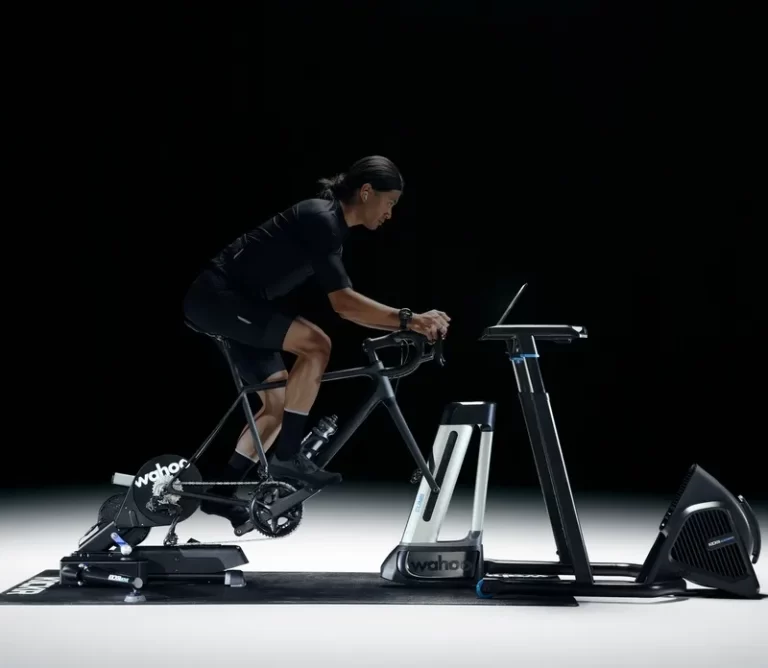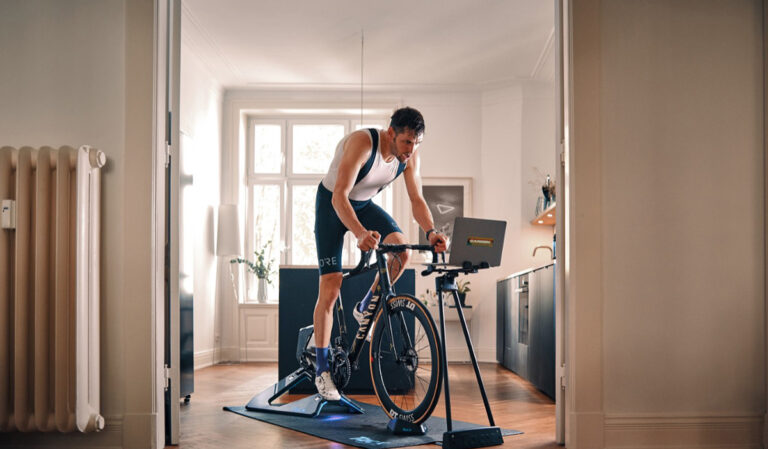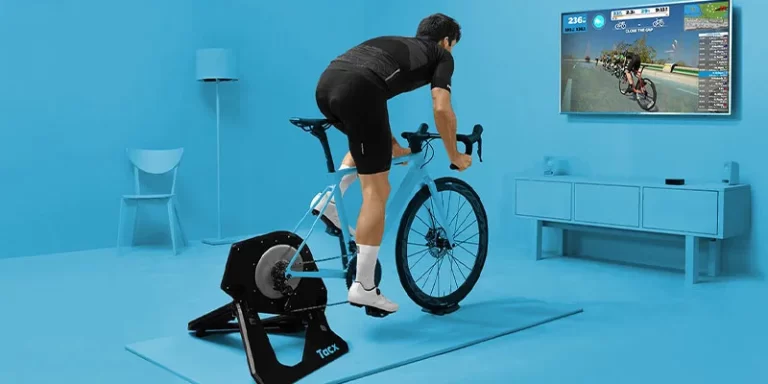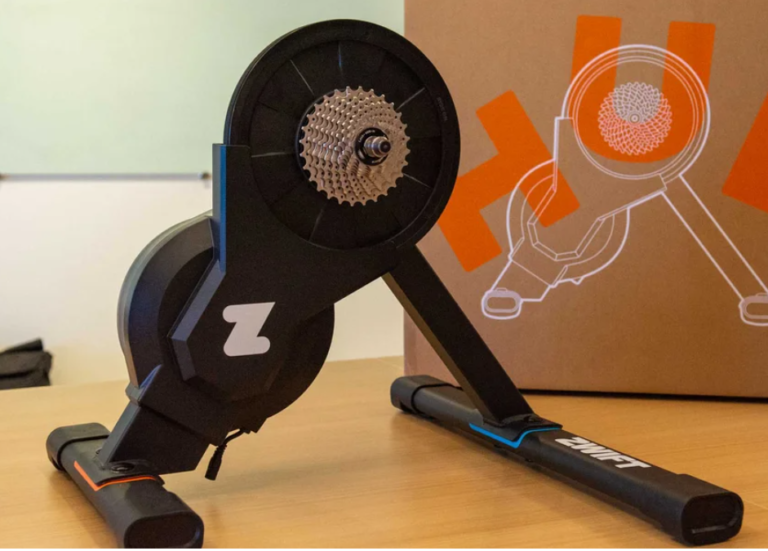Indoor Bike Trainer Buyer’s Guide
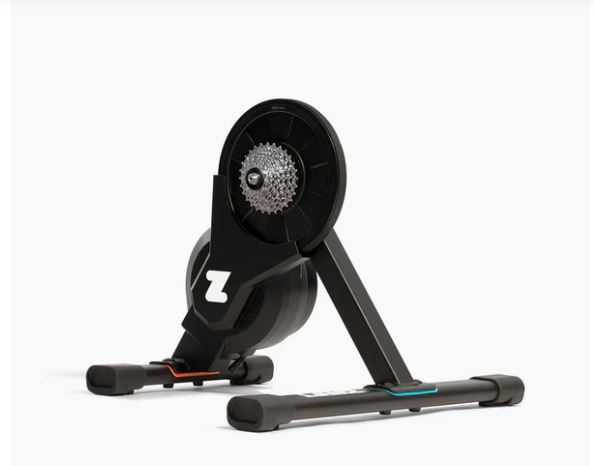
Indoor bike trainers are invaluable for cyclists seeking to maintain their training routines, improve their riding skills, or stay active when outdoor conditions are less than ideal. Whether you’re a novice cyclist or an experienced rider, choosing the right indoor bike trainer is pivotal for an effective and enjoyable indoor cycling experience. This Indoor Bike Trainer Buyer’s Guide provides detailed insights to help you make an informed decision when selecting an indoor bike trainer:
Types of Indoor Bike Trainers:
- Fluid Trainers:
- Pros: Fluid trainers employ a hydraulic mechanism to provide resistance, delivering a realistic road-like feel. The resistance increases as your speed does, mimicking the natural resistance curve of outdoor riding. They are notably quiet, allowing for undisturbed indoor training sessions.
- Cons: While fluid trainers offer a premium riding experience, they tend to be relatively more expensive than other trainer types. Additionally, they may require periodic maintenance to replace the fluid.
- Magnetic Trainers:
- Pros: Magnetic trainers use magnets to create resistance. They are often more affordable than fluid or direct-drive trainers and provide good resistance control. Magnetic trainers are relatively quiet, making them suitable for indoor use.
- Cons: Some riders find that magnetic trainers may lack the realistic road-like feel that fluid trainers provide. However, high-end magnetic trainers have improved on this aspect.
- Roller Trainers:
- Pros: Roller trainers are unique in that they require cyclists to balance on three cylindrical rollers while riding. This can help improve balance, pedaling technique, and core stability. They often require minimal setup and can be compact for storage.
- Cons: Roller trainers have a steeper learning curve, as they demand better balance and concentration. They typically offer less resistance than fluid, magnetic, or direct-drive trainers, making them less suitable for intense training.
- Direct-Drive Trainers:
- Pros: Direct-drive trainers eliminate the need for a rear wheel, as they attach directly to the bike’s frame. This design provides highly accurate power measurement and is exceptionally quiet. Direct-drive trainers offer a realistic road feel due to the elimination of tire-to-roller contact.
- Cons: These trainers are among the more expensive options on the market. They can also be bulkier than other types, which may be a consideration if space is limited.
Key Considerations:
When selecting an indoor bike trainer, these factors deserve meticulous consideration:
Resistance Type:
- Evaluate your training goals and preferences regarding resistance type. Fluid trainers are favored for their lifelike feel, while magnetic trainers offer affordability and control. Roller trainers are ideal for balance improvement and technique work, while direct-drive trainers excel in accuracy and quietness.
Compatibility:
- Confirm that your bike is compatible with the trainer you’re considering. Some trainers may require additional accessories or adapters to ensure a secure fit. Check compatibility with your bike’s wheel size and axle type.
Stability and Durability:
- Prioritize a trainer with a stable and durable frame capable of supporting your body weight. A secure riding experience is essential for effective training. Look for features like wide bases and adjustable legs for added stability.
Noise Level:
- Take into account the location where you’ll be using the trainer and your tolerance for noise. Fluid and direct-drive trainers are generally quieter than magnetic trainers, making them suitable for use in shared living spaces or apartments.
Portability and Storage:
- If you have limited space or plan to travel with your trainer, opt for a trainer that is easy to fold or disassemble for convenient storage and transport. Consider models with built-in handles for portability.
Smart Features:
- Consider whether you want smart features in your trainer. Smart trainers can connect to training apps and simulate real-world riding conditions, providing an interactive and engaging training experience. Look for compatibility with popular apps like Zwift, TrainerRoad, or Rouvy.
Power Measurement:
- If you’re serious about training and tracking your progress, investigate whether the trainer includes a built-in power meter. Accurate power measurement is valuable for structured training and allows you to monitor your wattage output.
Budget:
- Determine your budget for an indoor bike trainer and allocate funds according to your training needs and preferences. Entry-level trainers can offer cost-effective options, while high-end models provide advanced capabilities. Remember to factor in the cost of any necessary accessories.
Assembly and Setup:
- Examine the ease of setting up the trainer. Some models may require more assembly than others. Consider how quickly you can attach your bike and start riding, especially if you have limited time for training.
Accessories: – Explore the availability of accessories like a front wheel riser block, sweat guard, or training mat. These accessories can enhance your comfort and the effectiveness of indoor cycling sessions. A front wheel riser block can help level your bike and create a more natural riding position.
Warranty and Customer Support: – Ensure that the trainer comes with a warranty that provides adequate coverage. Additionally, research the manufacturer’s reputation for customer support and service, as this can be crucial in case of issues or inquiries.
Reviews and Recommendations: – Take time to read user reviews and seek recommendations from fellow cyclists. Real-world experiences can offer valuable insights into a trainer’s performance, reliability, and overall satisfaction.
Additional Tips:
- Whenever possible, test out trainers to assess how they feel and handle. The tactile experience can provide valuable information about the trainer’s suitability for your training goals.
- Tailor your choice of trainer to your specific training goals, whether it’s maintaining fitness, improving endurance, building power, or focusing on interval training.
- If you’re interested in joining virtual cycling platforms like Zwift, consider a smart trainer that offers interactive features for a more engaging and social training experience.
By meticulously evaluating these factors and aligning them with your unique needs and preferences, you can confidently select the ideal indoor bike trainer. Your chosen trainer will enable you to maintain or elevate your cycling performance, even when external conditions are less than favorable.
Click here to find the best indoor trainers rated and ranked
Happy Training! John
FAQ’s
How do I choose an indoor trainer?
Certainly, here’s the guide on how to choose an indoor trainer without numbering:
Identify Your Training Goals:
- Determine your primary training objectives. Are you looking to maintain fitness, improve endurance, build power, or work on specific cycling skills? Your goals will influence the type of trainer that best suits your needs.
Understand Trainer Types:
- Familiarize yourself with the different types of indoor trainers available, including fluid trainers, magnetic trainers, roller trainers, and direct-drive trainers. Each type offers unique features and benefits.
Consider Your Budget:
- Establish a budget for your indoor trainer. Trainers come in a wide price range, so knowing your budget will help narrow down your options.
Evaluate Resistance Mechanism:
- Decide which resistance mechanism aligns with your preferences and training goals:
- Fluid Trainers: Offer a realistic road-like feel and progressive resistance.
- Magnetic Trainers: Provide affordability and good resistance control.
- Roller Trainers: Improve balance and technique, but may have a steeper learning curve.
- Direct-Drive Trainers: Deliver high accuracy and quiet operation, with a lifelike road feel.
Check Compatibility:
- Ensure that the trainer you’re interested in is compatible with your bike. Some trainers may require additional accessories or adapters to fit your bike properly.
Consider Noise Levels:
- Think about where you’ll be using the trainer. If you live in a shared space or have noise-sensitive neighbors, opt for quieter trainers like fluid or direct-drive models.
Assess Stability and Durability:
- Look for a trainer with a stable frame and robust construction that can support your body weight during intense workouts. Stability is crucial for safety and effective training.
Review Smart Features:
- Determine whether you want smart features in your trainer. Smart trainers can connect to training apps and offer interactive workouts, virtual rides, and performance tracking. Assess your interest in these features.
Consider Power Measurement:
- If you’re serious about training and performance monitoring, choose a trainer with built-in power measurement or compatibility with power meters. Accurate power data can aid in structured training.
Evaluate Portability and Storage: – If space is limited or you plan to travel with your trainer, select one that is easy to fold or disassemble for convenient storage and transport.
Explore Additional Accessories: – Think about accessories like a front wheel riser block, sweat guard, or training mat to enhance your comfort and indoor cycling experience. These accessories can also protect your bike and flooring.
Research Warranty and Support: – Verify that the trainer comes with a warranty and research the manufacturer’s reputation for customer support. A reliable warranty can provide peace of mind in case of issues.
Read Reviews and Seek Recommendations: – Take the time to read user reviews and seek recommendations from fellow cyclists. Real-world experiences can offer valuable insights into a trainer’s performance and reliability.
Test Trainers If Possible: – Whenever possible, try out different trainers to assess how they feel and handle. Some cycling shops may offer test rides or demonstrations.
Match Trainer to Training Goals: – Ultimately, select a trainer that aligns with your specific training goals, preferences, and budget. Whether you prioritize realism, interactivity, affordability, or simplicity, choose the trainer that best suits your needs.
By following these steps and carefully considering your goals and preferences, you can choose an indoor trainer that enhances your indoor cycling experience and helps you achieve your training objectives effectively.
How do I choose a smart trainer?
Choosing a smart trainer requires careful consideration of your training goals, budget, and the features that matter most to you. Here’s a guide to help you choose the right smart trainer:
Identify Your Training Goals:
- Determine your primary training objectives. Are you looking to improve your cycling performance, maintain fitness, or engage in interactive virtual rides? Your goals will influence the type of smart trainer that best suits your needs.
Understand Smart Trainer Types:
- Smart trainers come in various forms, including direct-drive and wheel-on trainers. Understand the differences:
- Direct-Drive Trainers: These trainers replace your bike’s rear wheel and offer a more realistic road feel, accurate power measurement, and quieter operation.
- Wheel-On Trainers: These trainers require you to attach your bike to a roller, with your rear wheel remaining on. They are often more affordable but may provide slightly less accuracy and road feel.
Consider Your Budget:
- Set a budget for your smart trainer. They range from budget-friendly to high-end models with advanced features. Knowing your budget will help narrow down your options.
Evaluate Accuracy and Power Measurement:
- If precise power measurement is essential for your training, opt for a smart trainer with a highly accurate power meter. Some trainers have dual-sided power measurement, providing data from both legs for a more comprehensive view of your performance.
Check Compatibility:
- Ensure that the smart trainer is compatible with your bike. Some trainers may require additional accessories or adapters to fit your bike properly. Confirm compatibility with your bike’s wheel size and axle type.
Assess Connectivity and Compatibility:
- Consider the connectivity options the smart trainer offers. Look for Bluetooth and ANT+ compatibility, as these allow you to connect to various training apps and devices, such as smartphones, tablets, heart rate monitors, and cadence sensors.
Smart Features:
- Determine which smart features matter most to you:
- Virtual Riding Platforms: Some trainers are compatible with popular platforms like Zwift, TrainerRoad, and Rouvy, allowing you to engage in virtual rides, races, and structured workouts.
- Resistance Control: Look for trainers with precise resistance control that can simulate varying terrain and gradients for a more realistic riding experience.
- Interactive Training: If you want a more immersive training experience, choose a smart trainer that can adjust resistance in real-time based on the virtual terrain in virtual riding platforms.
- Performance Metrics: Some trainers offer comprehensive performance metrics, including cadence, speed, distance, and more. Decide which metrics are important for your training.
Noise Level:
- Consider the noise level of the smart trainer, especially if you’ll be training in shared living spaces. Direct-drive trainers tend to be quieter than wheel-on trainers.
Stability and Durability:
- Look for a smart trainer with a stable frame and durable construction to ensure it can support your body weight during intense workouts. Stability is crucial for safety and effective training.
Portability and Storage:
- If you have limited space or plan to transport your trainer frequently, choose a model that is easy to fold or disassemble for convenient storage and transport.
Research Warranty and Customer Support:
- Verify that the smart trainer comes with a warranty, and research the manufacturer’s reputation for customer support. Good customer support can be crucial if you encounter issues or have questions.
Read Reviews and Seek Recommendations:
- Take the time to read user reviews and seek recommendations from fellow cyclists. Real-world experiences can offer valuable insights into a smart trainer’s performance and reliability.
Consider Your Future Needs:
- Think about how your training goals may evolve. Choose a smart trainer that can accommodate your future needs, whether it’s increased resistance levels, compatibility with new devices, or expanded connectivity options.
By following these considerations and aligning them with your unique training goals and preferences, you can confidently select the ideal smart trainer to enhance your indoor cycling experience and help you achieve your performance objectives effectively.
Is an indoor bike trainer worth it?
Indoor Bike Trainer Buyer’s Guide Weather and Location:
- Indoor trainers are especially valuable if you live in an area with extreme weather conditions or limited cycling-friendly routes. They allow you to maintain your training routine year-round without being affected by rain, snow, or extreme heat.
Indoor Bike Trainer Buyer’s Guide Convenience and Accessibility:
- Indoor trainers offer the convenience of cycling at home or in a controlled environment. You don’t need to travel to a specific location, deal with traffic, or worry about safety concerns on the road.
Indoor Bike Trainer Buyer’s Guide Training Consistency:
- For athletes and cyclists serious about maintaining or improving their fitness, indoor trainers provide consistent and structured training. You can follow specific workouts, intervals, and training plans with precision.
Time Efficiency:
- Indoor trainers can be time-efficient, as you can get in a focused workout without the additional time spent on outdoor logistics like getting dressed, preparing your bike, or traveling to a suitable riding location.
Indoor Bike Trainer Buyer’s Guide Safety:
- Indoor trainers eliminate safety risks associated with outdoor cycling, such as traffic accidents, road hazards, and unpredictable weather conditions.
Performance Metrics:
- Many smart trainers offer accurate power measurement and performance tracking, which can be essential for goal-oriented training and monitoring progress.
Indoor Bike Trainer Buyer’s Guide Virtual Riding and Engagement:
- Smart trainers can connect to virtual riding platforms like Zwift, offering interactive and engaging experiences, including virtual races and group rides. This can make indoor training more enjoyable and social.
Indoor Bike Trainer Buyer’s Guide Time Flexibility:
- You can train on an indoor bike trainer at any time that suits your schedule, day or night, without being restricted by daylight hours or the weather.
Multi-User Accessibility:
- Indoor trainers can be used by multiple members of the household, making them a cost-effective fitness solution for families or shared living spaces.
Physical Rehabilitation: – For individuals recovering from injuries or surgery, indoor trainers can provide a controlled environment for rehabilitation and low-impact exercise.
Cost:
- High-quality indoor trainers, especially smart trainers, can be expensive. You’ll need to weigh the cost against the benefits and your budget.
Motivation and Enjoyment:
- Some people find indoor cycling less enjoyable than outdoor riding due to the stationary nature and lack of scenery. Ensuring that your indoor training is engaging and motivating is essential.
Space Requirements:
- Indoor trainers require a dedicated space, which may be a challenge in smaller living spaces. Consider whether you have the room for your trainer setup.
Noise and Disturbance:
- Depending on the type of trainer you choose, noise may be a factor. Magnetic and direct-drive trainers tend to be quieter, while fluid trainers can be noisier. Consider the noise impact on your household or neighbors.
In conclusion, an indoor bike trainer can be a worthwhile investment if you value training consistency, safety, and convenience, especially when outdoor cycling is not practical or enjoyable. Assess your personal fitness goal and preferences, your budget, and your commitment to indoor training to determine if it aligns with your needs and lifestyle.
